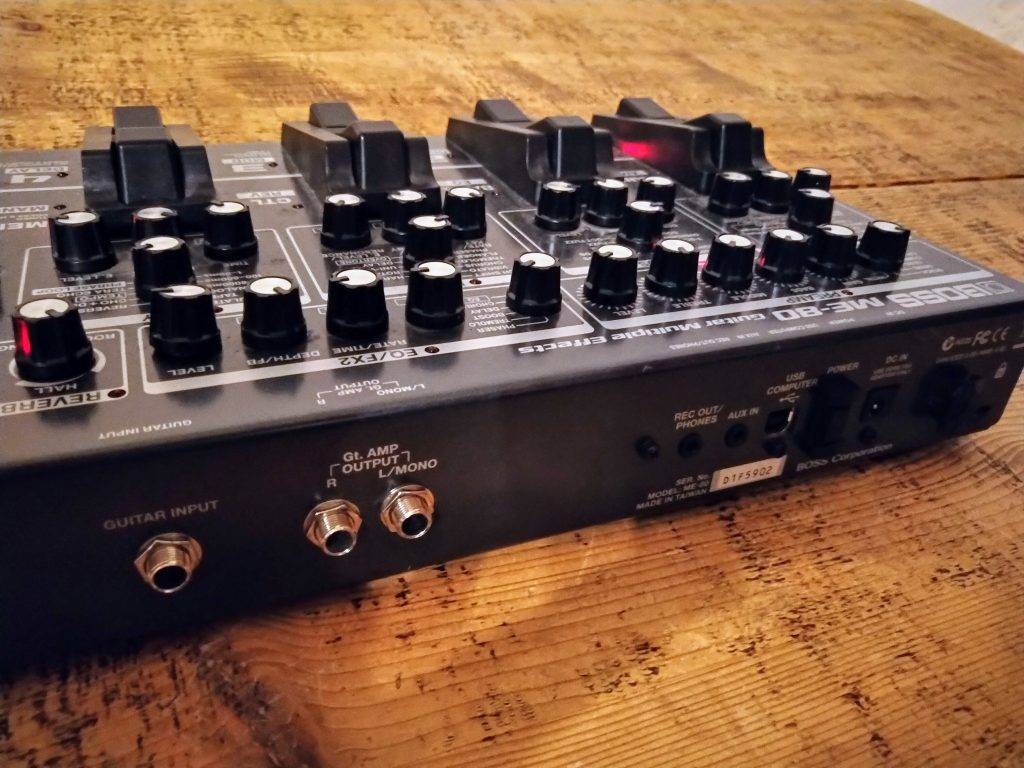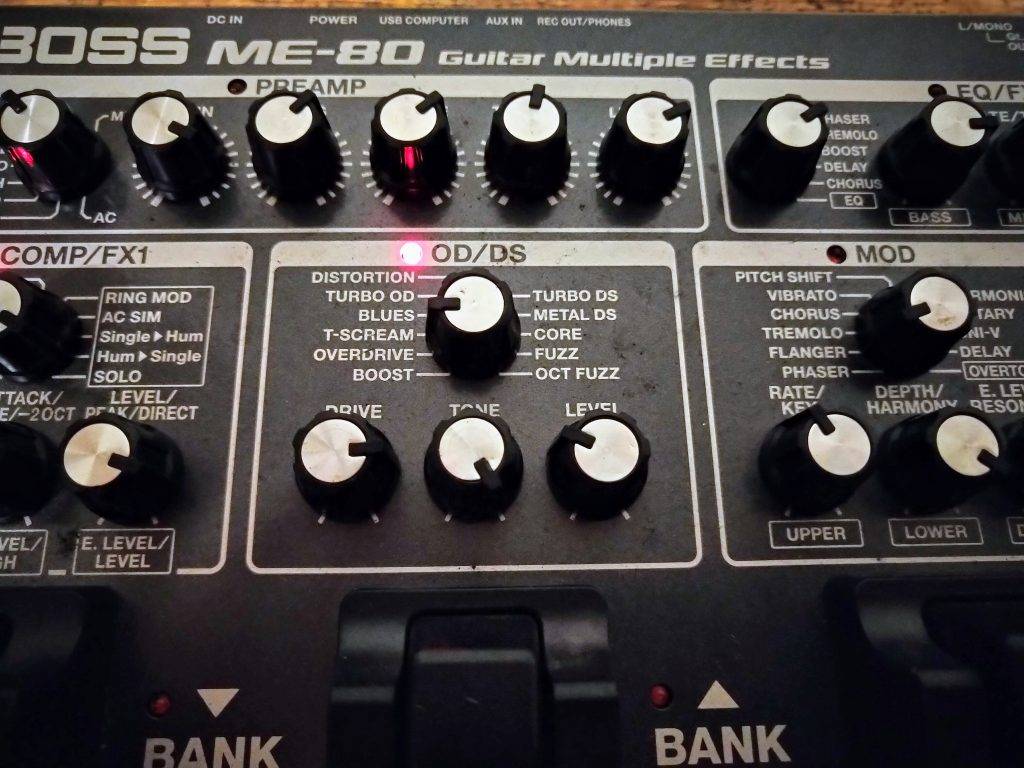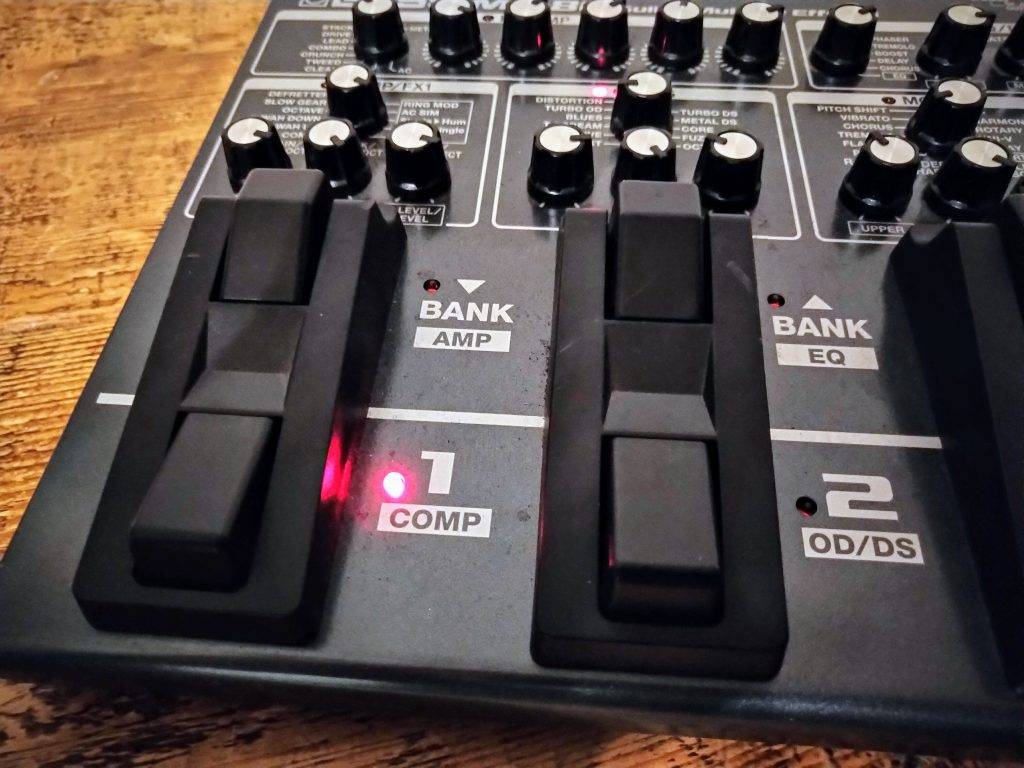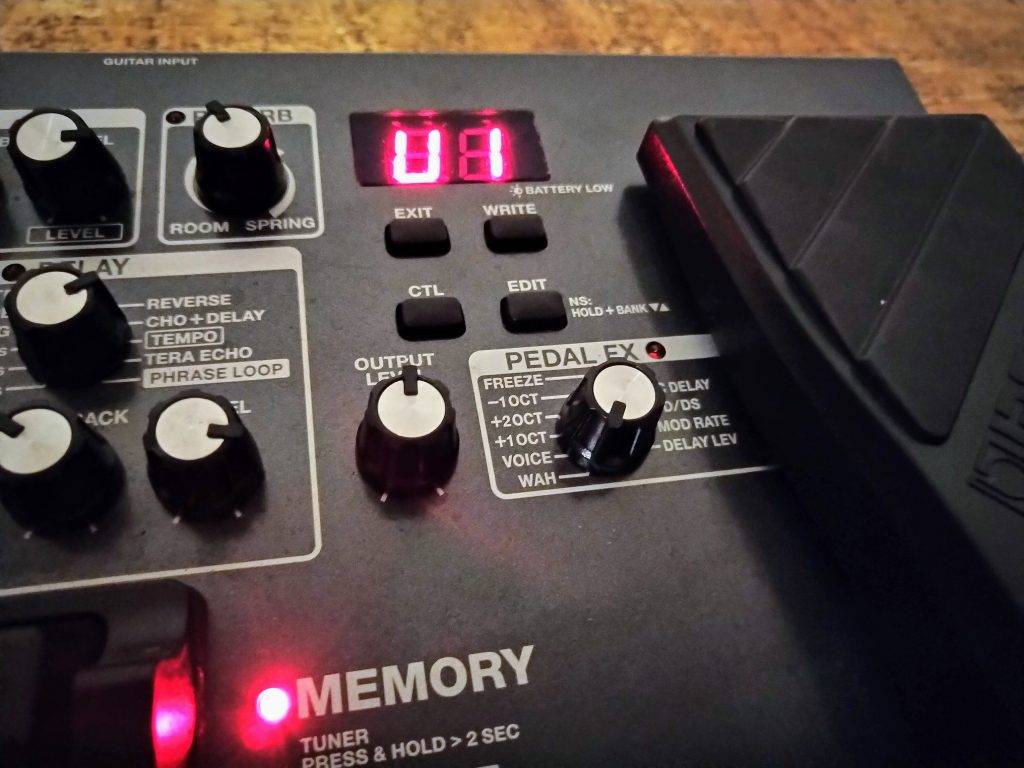In my 25 years of guitar playing, I’ve owned two ‘perfect’ guitar products. One is the BOSS Katana 50 Guitar Amp. The other is the BOSS ME-80 Multi-Fx. Read on to find out why….
Does the BOSS ME-80 possess BOSS’s legendary bulletproof build quality?
Right up until the time of writing, I would have given the BOSS ME-80 top marks in this category. It features sturdy metal casing, is reassuringly weighty, and looks to utilise the same tried and tested knobs found on BOSS’s indestructible compact pedal series. However, those protruding knobs can and will get caught, knocked off and twisted if, like me, you’ve been slinging it in a backpack for twelve months. In fairness to BOSS, that’s my fault, I was careless and had faith. But, just like the Katana, don’t expect miracles on what is a budget-priced product. Look after it and it’ll look after you.
The good news is that’s the only negative I can think of with regards to construction. The pedals (both the footswitches and expression pedal) are chunky and hard-wearing, the connections are positive and solid, and there isn’t a lot of LCD/LED real-estate to worry about.

Is the BOSS ME-80 easy to use?
Unless you’re going straight into the amp with individual pedals. It doesn’t get any easier than this. You have eight distinct effects ‘blocks’ Preamp, EQ/FX2, Reverb, Comp/FX1, OD/DS, Modulation, Delay and Pedal FX, each with their own on/off switch (or an expression pedal toe press for Pedal FX). In addition to this, we also have a dedication footswitch to flick between MANUAL and PRESET mode, as well as hold for the built-in tuner.

Let’s start with MANUAL Mode, shall we?
Here it’s a WSYWIG interface where you can switch FX blocks in or out as you would an array of eight pedals. For my personal use, I go into a clean amp so I use :
- The Turbo OD type of the OD/DS block for an overdriven rhythm sound, which becomes clean when switched off.
- The Solo type of the Comp/FX1 block which gives me a handy volume AND gain boost for soloing.
- The Flanger type of the Modulation block.
- The Chorus type of the EQ/FX2 block. Which allows me to switch independently between Chorus, Flanger or both.
- The Analog Delay type of the Delay Block
- The Wah type of the Pedal FX block.
The above configuration covers 99% of my set and allows me to simply engage/disengage the FX I need when I need them. But what happens if you need a wildly different tone? That’s what PRESET Mode is for.
Switch to PRESET mode (with your foot) and the bottom row of switches become your patches 1-4, with the top 3 becoming bank up, bank down and the intriguing CTRL switch (more on that later). If you prefer to use tones per song, this mode has you covered.
When I first saw the BOSS ME-80, I was a little concerned about the closeness of the footswitches. It’s a newer designed where they are sort of ‘stacked’ one on top of the other. However, in a year’s gigging with my size 12’s, not once have an accidentally selected the wrong switch. They look far too close, but in practice, they’re designed so that it’s very difficult to hit the wrong one.
Lastly, what’s really great about the BOSS ME-80 are the things you don’t notice. It’s quiet, there’s no switching lag in any of the modes. It just doesn’t present the end-user with any issues, which can’t be said for a lot of Multi-FX.
The surprising versatility of the BOSS ME-80
The way the BOSS ME-80 combines ease of use with versatility is a master-stroke. Do you want to keep it simple? Use MANUAL mode. Do you prefer to craft a specific tone per set/song? Use the PRESET mode. Where the ME-80 shines, is in its ability to foot-switch between the two, with no sonic delay, giving you the best of both worlds. The icing on the cake is the CTRL switch, which allows you to set up a parameter change (or range of changes) and assign it to the CTRL footswitch.
A classic example would be increasing the gain and volume of the OD/OS block while adding a touch more MIDS in the EQ/FX2 block to give a foot-switchable lead boost for that particular preset. Sure you could also use the SOLO option of the Comp/FX1 block, but you get the idea. The only limitations are your imagination and the inability to change between FX types of the block in question. You can’t for example setup CTRL to switch between the T-SCREAM and OVERDRIVE types of the OD/DS block.
BOSS has also designed the FX blocks to give you access to the same effect from two different places. The advantage of this is using two separate foot-switchable delays, one from the Delay block and one from the Modulation block if you need a subtle short delay and a dramatic long delay in the same song for example. Another scenario would be using a Chorus from the EQ/FX1 block to free up the Modulation block for a Flanger etc.

Are the sounds of the BOSS ME-80 good enough to gig with?
I’ve gigged with a variety of gear, a lot of it documented on the Blogging Musician. We’re talking valve-amps, separate pedals, a variety of Mult-FX, 2-cable, 4-cable method, just about everything you can imagine. The bottom line is I can get to the live sound I need with a clean amp (The BOSS Katana 50 in my case), the BOSS ME-80 and 2 leads.
Is it going to compete with a mic’d up cranked valve amp + pedals for recording? No.
Is the USB direct going to compete with the latest from Line 6 / BOSS for PC recording? No.
Gain
Actually, for live use, despite what you read online, I’ve all but disregarded using the Preamp section at all. It just seems too compressed. rather I use the Turbo OD type of the OD/DS block in isolation, as it gels so much better with a cranked clean amp, getting me into that naturally gritty, sustaining, happy place where notes bloom into harmonic feedback if you let them. It cuts the mustard, and allows me to forget about the hassles of valves, cabling and power supplies. I’m old enough now to know what I want from an overdrive/distortion pedal, and to my ears, the Turbo OD has just the right amount of oomph, mids and sizzle I need to cut through the band mix for a variety of rock/Indie and pop.
Of course, there’s a whole host of other flavours in the OD/DS section. The Blues Driver disappoints compared to the original, being too spiky and thin, the T-SCREAM gives you a dollop of mids but, like the Preamp, compresses things a little too much, losing yourself in the mix, live at least. However, BOOST and OVERDRIVE would absolutely work in a lighter gained scenario, providing a surprisingly natural gain structure, rare in a budget multi-fx unit. Sadly the higher gained metal tones offer predictable levels of thin fizz I struggle to find a use for.
The Preamp section isn’t without its uses though. It finds its home through headphones, for recording, or direct to PA as an amp substitute (should the worst happen in the middle of a gig). Yet another reminder of the BOSS ME-80’s ability to be all things to all men (or women).
Special mention has to go to the ME-80’s Solo function. Something I’ve been waiting a long time for in FX units, which is simply a dedicated switch to boost volume AND gain (plus EQ). This top-trumps units such as the TC Electronic Nova system (volume boost only) and Zoom’s G series (boost exists on amp models only). One thing worth mentioning here is that you can’t use the Solo with any other of the eminently useable Comp/FX1 types (Single Coil>Hum would have been great), which is a shame.
In other words, with regards to dirt and a configurable boost, the ME-80 works for me and I suspect a lot of guitarists out there.

FX
When it comes to time-based FX, the BOSS ME-80 makes less of an impact. The stars of the show are undoubtedly the choruses, which, as you would expect from BOSS are full, lush and expansive. Your delay needs are also absolutely met with a wide range of options including digital, tape, analogue and even the new Tera Echo if soundscape special FX are your thing. VERY interesting indeed. The Flanger frustrates in that it’s difficult to set up something subtle, or low in the mix. Lastly the Wah, and for that matter, all of the Pedal FX (Including useful slides) just about perform their functions and nothing more.
The BOSS ME-80 lacks the dramatic crystalline detail of the Nova system in the time-based FX department, and can’t compete with a trusty Dunlop CryBaby for vowely, authentic, organically-tactile wah-wah shenanigans, it’s just too polite, but the key point is, it still works.
Value For Money
I purchased the BOSS-ME 80 second-hand for £110. That’s £110 for a device that gives me my main OD, a solo-boost, a tuner, a wah, a delay and any other time-based effects I’ll ever need for live gigs. That puts it above any criticism really, especially when you consider it’s competition is priced way higher anyway. If you don’t bash it about as I did, there’s no reason why it can’t last you a lifetime. An absolute bargain!
BOSS ME-80 Gold Stars
- Fantastic OD/DS tones, particularly the Turbo OD.
- Preamp section can be used as an amp backup direct to PA.
- Rugged construction.
- Classic BOSS Choruses and Delays.
- An indispensable, configurable SOLO boost.
- Six Duracell AA’s will easily get you through a 2-hour gig and beyond.
- Very simple and intuitive, yet VERY versatile. Use it as a pedalboard, programmable patched or both, all at your feet.
- Configurable CTRL opens up a whole new world of switching possibilities.
- Unbelievable price.
BOSS ME-80 Black marks
- COSM modelling isn’t going to compete with the latest tech in a head to head.
- Uninspiring pedal FX
- Poor high gain/fuzz/metal tones
- Unsubtle flanger
- Plastic pots are NOT indestructible
- Would have been useful to be able to use Solo AND other Comp/FX1 types.
- Must be used in front of a clean amp. No 4-Cable method here.
- Green LED to indicate ‘In tune’ would have been great. We had that way back on the BOSS ME-50.
- CTRL can’t switch between FX block types.
- Power supply not included.
BOSS ME-80 Competition
- ZOOM G5n – The closest direct competition to the BOSS ME-80. I’m a big fan of Zoom (I absolutely loved the Zoom G3), but here we have a cluttered LCD display, memory issues when combining FX and a solo function which operates on the amp models only. However, the ZOOM G5n’s feature and FX set dwarves the ME-80 if experimentation is your thing.
- TC Electronic Nova System – Full Review here. No expression pedal, confusing, clunky interface and a higher price tag. Also, there are delays when switching between presets. If your willing to put up with all of that (I wasn’t) then the Nova system will reward you with analogue drive/distortion and best in class modulation and delays. A professional ‘sounding’ package at least.
BOSS ME-80 Specs
- Compact and powerful floor multi-effects with simple knob-based interface
- Eight simultaneous effects categories, each with multiple effects types
- Dial up tones with the ease of using your favourite stompboxes
- Includes a massive selection of top-quality effects, from classic Boss stomps to the latest MDP effects
- Updated flagship-level COSM amps derived from the GT-100
- Eight multi-function footswitches and expression pedal
- Manual mode for stompbox-style on/off; Memory mode for switching complete patch setups
- Delay section includes Phrase Loop function with 38 seconds of recording
- Runs on six AA batteries or optional PSA-series AC adapter
- USB audio/MIDI interface built in
- Free Boss Tone Studio software allows you to edit and organise tones on your computer, and also preview and download free patches directly from the Boss Tone Central website
BOSS ME-80 Feature / FX List
- Preamp – AC, CLEAN, TWEED, CRUNCH, COMBO, LEAD, DRIVE, STACK, METAL
- COMP/FX1 – COMP SUSTAIN, T.WAH UP, T.WAH DOWN, OCTAVE, SLOW GEAR, DEFRETTER, RING MOD, AC SIM, Single > Hum, Hum > Single, SOLO
- OD/DS . BOOST, OVERDRIVE, T-SCREAM, BLUES, TURBO OD, DISTORTION, TURBO DS, METAL DS, CORE, FUZZ, OCT FUZZ.
- Modulation – PHASER, FLANGER, TREMOLO, CHORUS, VIBRATO, PITCH SHIFT, HARMONIST, ROTARY, UNI-V, DELAY, OVERTONE
- Delay – 1–99 ms, 100–600 ms, 500–6000 ms, ANALOG, TAPE, MODULATE, REVERSE, CHO + DELAY, TEMPO, TERA ECHO, PHRASE LOOP
- EQ/FX2 – PHASER, TREMOLO, BOOST, DELAY, CHORUS, EQ
- PEDAL FX – WAH, VOICE, +1 OCT, +2 OCT, -1 OCT, FREEZE, OSC DELAY, OD/DS, MOD RATE, DELAY LEV
- Noise Suppressor
- Reverb
- Tuner
Conclusion
Just about every criticism I’ve made on the BOSS ME-80 is understandable and forgivable given the price tag. If you’re looking to simplify your setup, but were concerned (like me) about a multi-fx’s ability to produce authentic overdrive tones. then be concerned no-longer. The BOSS ME-80 absolutely delivers as a one-stop solution into the clean amp of your choice. It sounds massive through my BOSS Katana 50 and maybe even better through a clean valve amp. It can’t compete with the best in class with regards to individual sounds, but as a configurable, intuitive and robust gigging tool/solution, I believe it is without equal and up there with the BOSS Katana 50 as one of only two ‘Perfect’ guitar related purchases I’ve ever made. Just add a guitar and you’re away!
Full details & spec @ https://www.boss.info/global/products/me-80/
More Guitar Gear Reviews @ The Blogging MusicianT
Thinking about buying a BOSS ME-80?
You can support the blog by ordering through my Guitar Centre affiliate link here, or by clicking the image below.


Leave a Reply